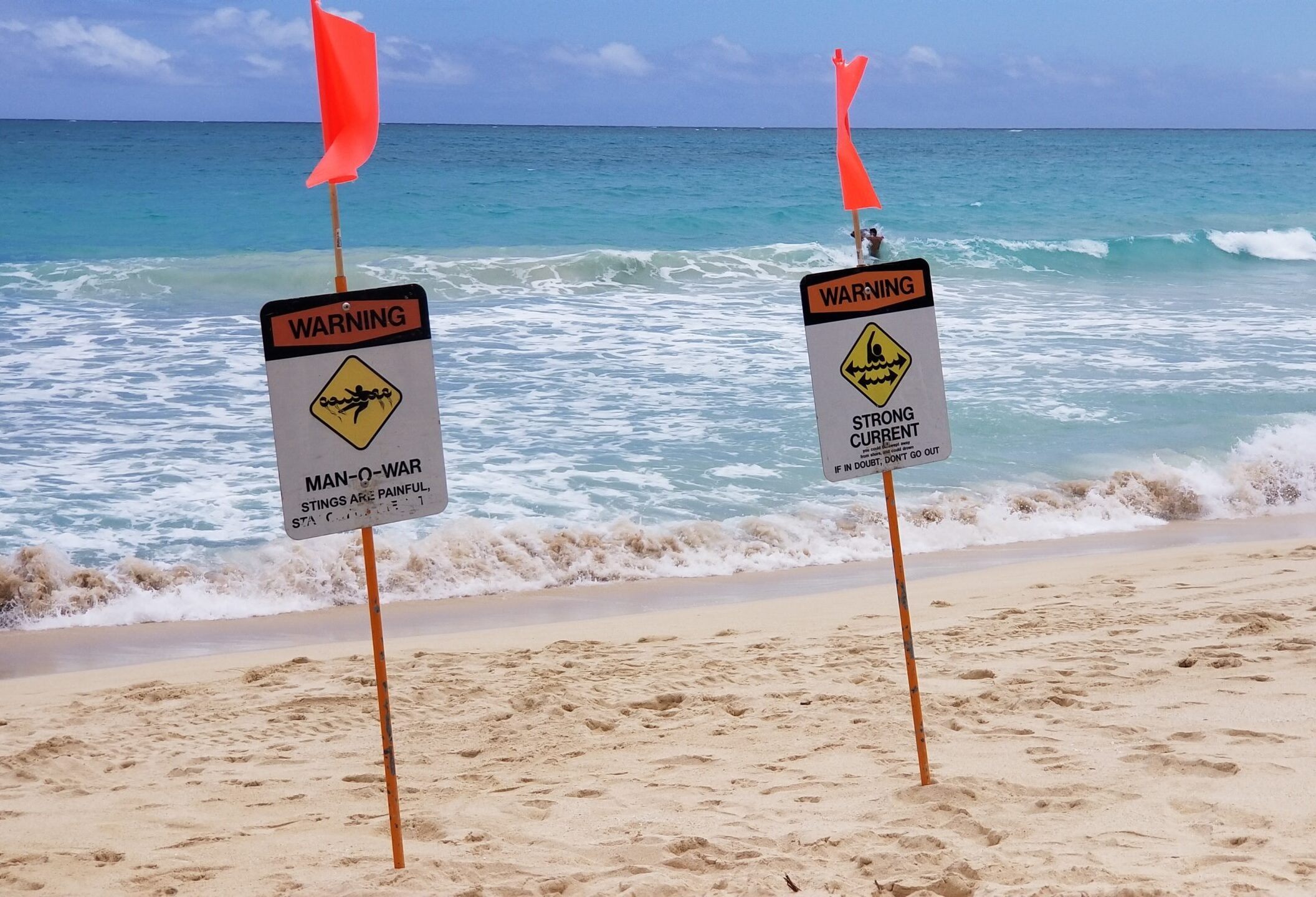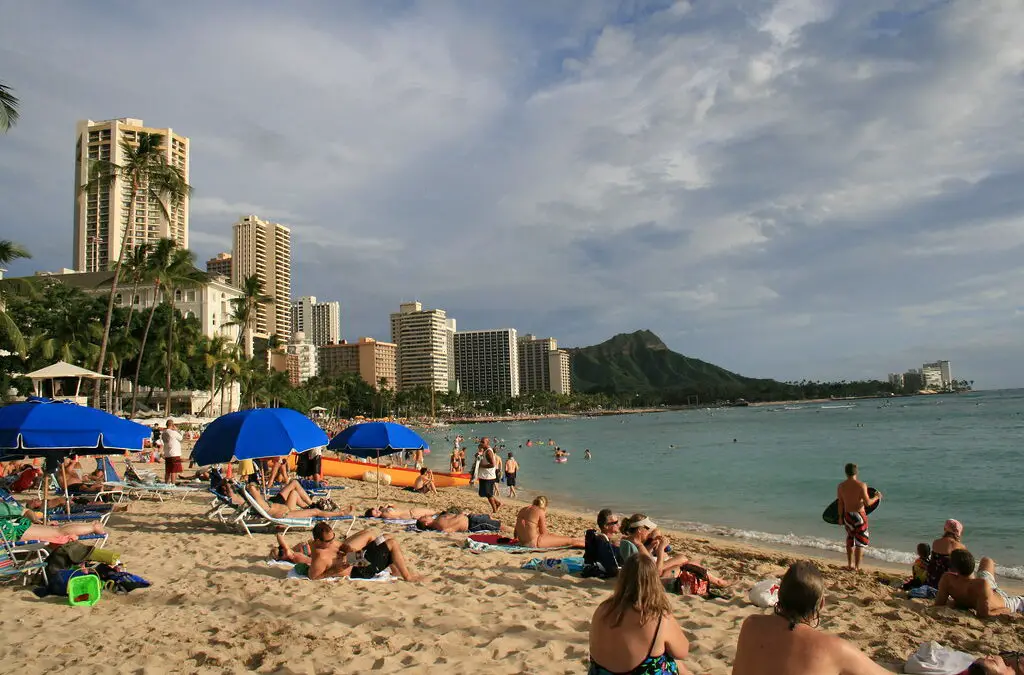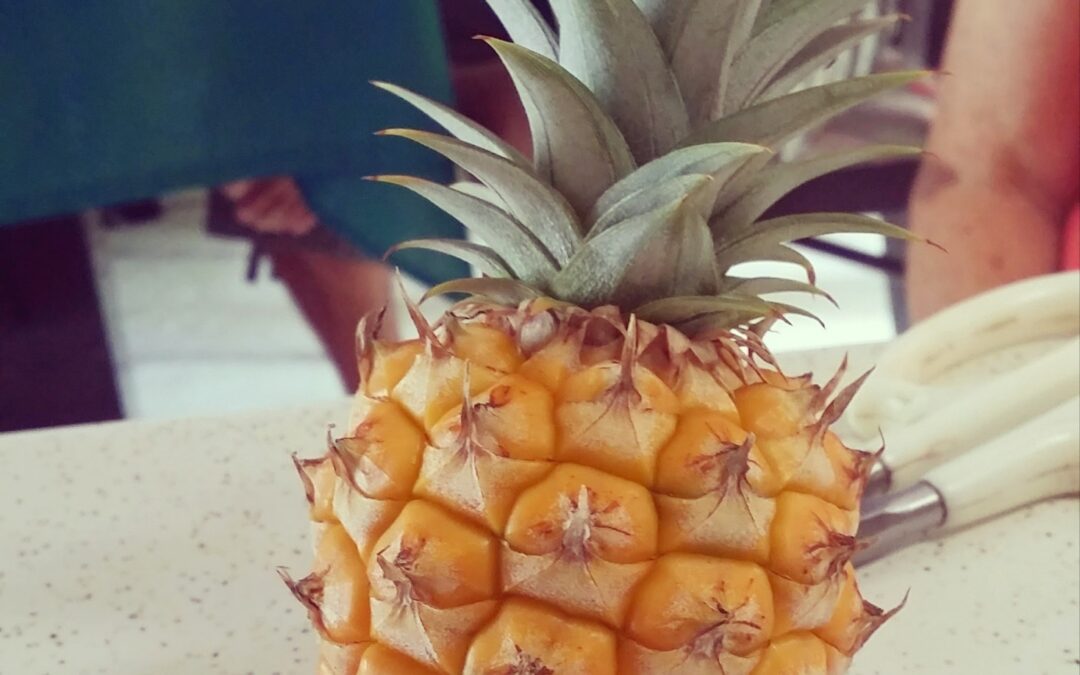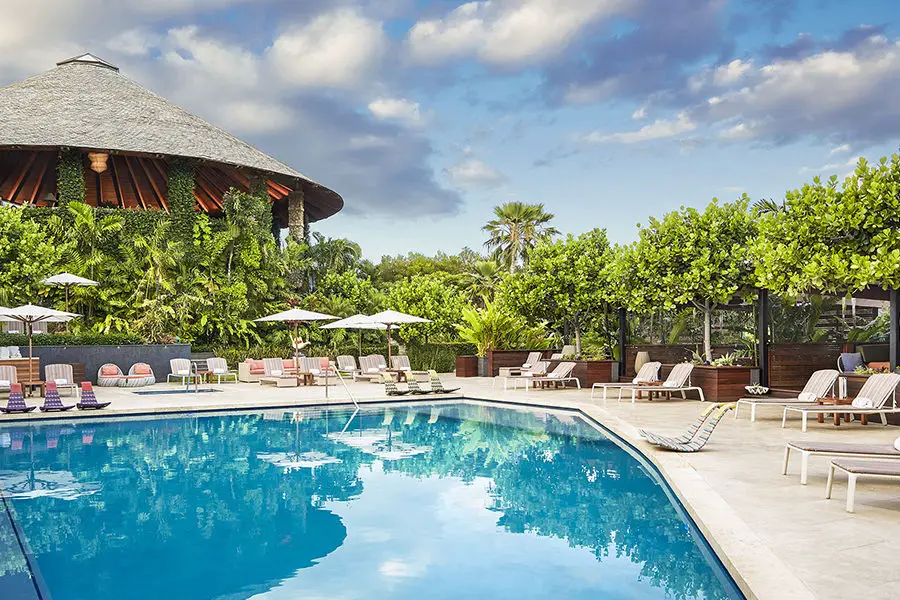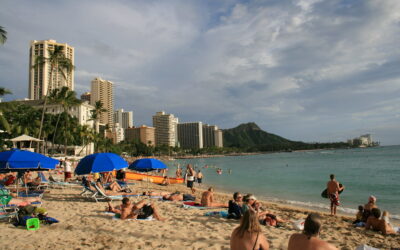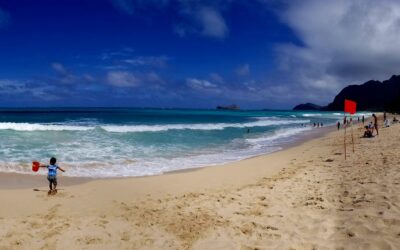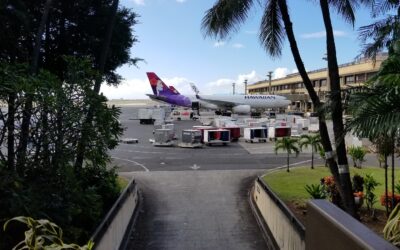Overall, for tourists and residents alike, Hawaii is a generally safe place to travel. That being said, every place has its “things” and hopefully, this will help keep everyone safe so you and your family can really relax and enjoy your Hawaii vacation!
AT THE BEACH
Always be aware of and respect the ocean. I’m not sure if this is because I grew up in Hawaii but the idea of “Never turn your back on the ocean” has been ingrained in my brain for as long as I can remember.
I used to think this was just a generic warning (like “no running in the hallways” at school), but after living in Hawaii for over 20 years and hearing cases of people – tourists and residents alike – getting swept off a ledge, sucked into a wave, or worse, I’ve realized it’s more than something people just say.
For me, respecting the power of the ocean means I can have fun while not taking for granted that the ocean isn’t some water ride in a theme park. Plus, I’ve had my own share of dumb (but thankfully not life-threatening) ocean experiences over the years, so those have helped me develop a healthy respect for the ocean too????.
Check out the Hawaiian Lifeguard Association site for more on beach conditions and safety: https://hawaiibeachsafety.com/
The beaches in Hawaii are gorgeous and often after playing in the calm waters of Ko’Olina Lagoons on the west side or Prince Kuhio Beach in Waikiki, it can be easy to forget that the ocean is a powerful, sometimes dangerous force of nature.
Here are a few things to keep in mind:
1. Check the weather.
When I was a kid growing up in Hawaii, it didn’t always matter if rain was in the forecast, we’d still go to the beach; Hawaii’s rain was warm, and even with the occasional downpour, the beach was still fun. Nowadays, Hawaii’s weather has changed! I’ve seen wind funnels at the beach lifting tents off the ground, lightning striking the ground and the open ocean, and even heard some beaches experience polluted water run-off during and after a storm. So, my rule with the kids is, if it’s lightly drizzling, I still might go, but anything more and we’re postponing our beach trip to another day.
2. Check the signs on the beach before going into the water.
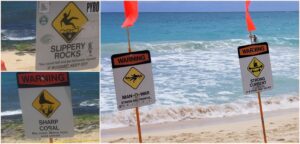
Pay attention to the signs at the beach.
If the water is polluted, if the currents are unusually strong, if jellyfish are in the area, or if the waves are rough, there will be signs posted along the beach. As a side note, jellyfish and Portuguese Man-of-War may be floating around at any time but there are times when there are a LOT of them ~ that’s when the lifeguards will post signs.
These are not generic warnings, they state the conditions of that particular beach for that day.
3. Know your limits.
If you’re not a strong swimmer, don’t venture out too far. Actually, even if you are a strong swimmer, some currents can be quite strong, so don’t get cocky ????. This also goes for those jump-off spots posted all over social media ~ they may look fun but some of these areas have quirky variable tides, strong currents, and/or sharp rocks below. If your choose to participate, just be aware and observe before you jump. Quite a lot of people – tourists and locals alike – have suffered severe spinal injuries as a result of these jumps. If you’re not familiar with the area, err on the side of caution and have a safe and injury-free vacation.
4. Swim at beaches with lifeguards.
If at all possible, I’d recommend swimming only at beaches with lifeguards. They know the beaches well and can tell you if there are currents, drop-offs, or even if there is an influx of jellyfish or Portuguese Man-of-War. Of course, there are signs posted but, personally, when I have to watch more than one child and/or if I’m not a strong swimmer myself, I’d feel more comfortable knowing that there are lifeguards nearby.
5. Avoid swimming at night.
I honestly thought this was because you can’t see, but I’ve since learned that it’s also because some shark species tend to swim closer to the shore to feed at sunset and into the night. Don’t be the snack!
6. Avoid isolated beaches at night.
This is simply a personal safety thing, plus, many beaches are technically closed at night. Hawaii is generally safe, but if you want to go for a walk along the beach at night, I’d stick to Waikiki and beaches along the large resorts. I’ve also hung out at beaches at night while visiting or renting a beach house but there were other people walking around as well; so basically, just check – if you see other people out for walks, it’s probably okay.
7. Watch out for box jellyfish and Portuguese Man-of-War.
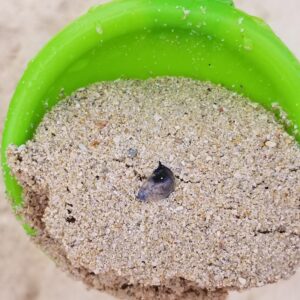
Watch out! Even a tiny Portuguese Man-of-War can pack a big sting!
Box jellyfish usually appear in large numbers about 8-10 days after every full moon; I don’t know if the Portuguese Man-of-War follows the same or similar cycle. There will be signs posted at the affected beaches when there are a lot of jellyfish and/or Portuguese Man-of-War in the water and often, you’ll see them washed up on the beaches if they’re around. If you come across one on the sand, DO NOT touch it! (The Portuguese Man-of-War are quite pretty so be careful, especially with small children.) The bubbles don’t have venom, but the tentacles can still sting even after they’re dead and I’ve seen people try and pick them up by the bubble to remove them only to have the tentacles wrap around their arms. If you do get stung, don’t panic! Rinse the affected area with vinegar, remove any remaining tentacles with tweezers,* and apply heat (not ice!). The vinegar will stop the stinging cells from firing and the heat will deactivate the venom. For more info about treating jellyfish stings, I think the Maui Ocean Center has the most easy-to-read information.
*Do not brush off the tentacles, that can end up releasing more venom into your body, remove them with tweezers instead.
8. Protect your valuables.
I frequently leave my belongings on the beach while I play in the water with kids and have never had any problems, but as a tourist destination, theft is definitely a possible occurrence. I tend to frequent high-traffic, gentle, family-friendly beaches like Ala Moana Beach Park or Prince Kuhio Beach in Waikiki, so that might be a factor as well. Also, I often keep my phone around my neck in a floatable plastic holder so I can take pictures anyway but I make sure I keep my car keys and wallet tucked away. If possible try to avoid bringing valuables to the beach altogether.
WHEN HIKING
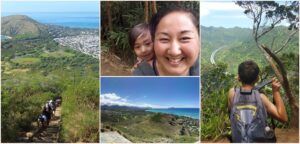
Hiking with the family ❤️
First off, I love hiking in Hawaii. We don’t have to worry about poison ivy or poison oak. Second, there are no bears, wolves, coyotes, foxes, snakes, wild cats (well, just wild kitty cats), or any other predator that had me keeping my little kids close when we would go on hiking trails in Minnesota. And, third, the scenery and views are always so beautiful. That being said, there are still a few safety practices you should keep in mind while hiking in Hawaii, and often forces of nature or careless behavior are the causes of major (sometimes fatal) accidents.
1. Check the weather before you go.
If it’s raining or there’s rain forecasted, it’s usually better to avoid hiking in that area. Flash floods are a real thing in Hawaii and there have been situations where hikers have been swept away during a flash flood. Not to mention that heavy rains can adversely affect the trails, making them crumbly and slippery.
2. Lock your car and keep valuables out of sight.
I’m not gonna lie. To most Hawaii locals, tourist vehicles often stick out like a sore thumb. I think it’s the combination of color, make and model, and maybe even how clean it looks?! I’m not sure. Regardless, the fact is, if someone like me can tell, then thieves can definitely tell. Although I have never actually seen break-ins while hiking, I have heard that sometimes hikers’ cars get targeted because thieves know they will be gone for a while. To be safe, if available, we always park in the designated lot or at least somewhere highly visible. Also, we never really bring anything valuable that we won’t take with us (i.e. IDs and phones).
3. Bring sunscreen AND apply it regularly.
Even if you’re under the cover of Hawaii’s beautiful tropical rainforests, you can still get sunburned. And, of course, it’s 10x worse if you’re hiking on a trail with no shade or tree coverage. Even if you apply sunscreen before you go, most sunscreen requires reapplication every 60-90 minutes and many hikes are long enough that you’ll need to reapply. Sun blisters are not a good look (or feel) for your vacation and probably not the kind of souvenir you want to bring home! For more info check out our article about Hawaii’s reef-safe sunscreens.
4. Bring water with you.
It can get hot while hiking in Hawaii and it’s terrible when you realize you don’t have enough water at the mid-point of your hike. If you have little ones with you, please bring extra water (more than you think you need). I often joke that my husband and I feel like pack-mules when we go on family hikes since we’re usually carrying the backpack with extra water bottles, bug spray, and sunscreen, but it beats having your child feeling sick from heat exhaustion and not having enough water. At least, as the kids got older, they started carrying their own packs with water ~ thank you Cub Scout training! ????????
5. Bring mosquito repellent.
Ah, this is one I sometimes forget and it’s partially because half our family, including me, rarely get bitten. Unfortunately, the other half, including my husband, are like walking buffets for the local mosquitos. Without bug repellent, they’ll often come back from a hike with 20 or more mosquito bites, especially if we’ve been hiking in a rainforest area. So, as I reminder for myself and everyone else, please bring the repellent, your more tasty-blooded family members will thank you for it.
6. Stay on the trail.
This recommendation is two-fold: for your safety and to protect the vegetation and wildlife in the area. It’s unfortunately common to hear helicopters rescuing hikers who were lost because they veered off the trails. Even more tragic, is when we see a fatal accident in the news after someone falls off a cliff or ledge because they ventured off the path and didn’t see a drop-off. So, stay on the path, the selfie is NOT worth it! In terms of preserving Hawaii’s indigenous plants and flowers, staying on the trail means you’re helping to preserve Hawaii’s natural beauty by keeping our rainforests intact for the native plants and birds living in the area ~ many of which may be classified as endangered.
7. Avoid leptospirosis: don’t drink stream water or enter waterfalls and freshwater pools if you have open cuts.
I know many visitors have fantasies of standing under beautiful Hawaiian waterfalls or gracefully diving into one of Hawaii’s waterfall-fed pools, but the fact is, this isn’t always safe. I’ve gone into freshwater streams myself, but you need to keep in mind that if you have cuts, ingest the water, or get stream water in your eyes, nose, or throat there is a possibility of contracting leptospirosis – a bacterial disease found in Hawaii’s freshwater streams. Growing up with a Mom who works in the healthcare industry, I could probably pronounce leptospirosis since I was six. In fact, hearing her saying, “Don’t go in the water, you could get leptospirosis and die!” was almost the equivalent to “Have a good day at school” when I was growing up – especially since I paddled in the Ala Wai Canal during high school for our paddling team. I personally never knew of anyone who contracted leptospirosis but Hawaii has about 30-40 cases per year and the overall national fatality rate is between 5-15% so, thanks, Mom ~ I appreciate your warnings now!❤️
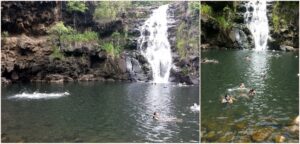
Waimea Falls has a lifeguard and is regularly monitored so I feel like it’s a safe place to swim. You do have to wear a life vest if you want to be in the water, though.
I’m adding a fact sheet from the Hawaii Department of Health for more detailed information here.
8. Charge your phone and bring it with you.
We’ve never really had an issue, but whenever we go on a hike, I always text my Mom or Grandma with where we’re going and I always made sure my phone is charged. Not only do we have the means to take awesome pictures of the kids as they explored the trail, but it’s also a good way to track your location and call for help if you ever get lost.
WHILE OUT AND ABOUT TOURIST-ING AROUND
1. Keep your personal valuables with you at all times.
Personally, I have never been a victim of pick-pocketing in Hawaii but we live here so while it would be a hassle to cancel and replace IDs and credit cards, I’d imagine it would be 10x worse as a tourist! Take extra care of your IDs, credit cards, and cash while you’re on vacation – I think Hawaii is pretty safe, but we shouldn’t be careless either.
2. Take pictures, not lava rocks and sand.
Please remember that it is illegal to take items from National Parks so in Hawaii that would mean you cannot remove items from Volcanoes National Park on the Big Island and Haleakala National Park in Maui. However, even if there are no legal repercussions, if you could kindly leave the sand at the beaches it would be much appreciated. That way, everyone can enjoy our beautiful beaches ~ and you’ll have beaches to come back to when you visit again!
3. Don’t get yourself locked in a park!
Okay, this hits close to home because we actually experienced this when we first moved back. We were visiting Hoomaluhia Botanical Gardens and heading out when our kids had to use the bathroom. The bathrooms were still open so we thought we’d have enough time to let them go and then head on out, but that is NOT the case for the county or state-run locations in Hawaii.
If you’re visiting a county or state-run museum, park, library, etc. make sure you know their opening and closing (especially closing!) hours. The workers tend to close up the gates pretty much on time and I think they tend to close the main doors or main gate first so no one else can get in while they close up the rest of the buildings. In our case at Hoomaluhia Botanical Gardens, we drove down and found the entrance gate locked up less than 10 minutes after the listed closing time. This must happen on occasion because there was a contact number for the security office at the gate. We had to call them and then someone had to drive down to let us out. Since they were in the middle of locking up the other buildings we just had to wait a little bit for them to finish up before they came down to let us out. They were nice about our mistake, but our 5-minute bathroom stop added an extra 20+ minutes to our leaving time. Oops!
4. Check the temperatures (and weather).

The top of Haleakala is a little over 10,000 ft.
If you’re going to Pearl Harbor or a museum, or a luau, chances are, the weather and temperatures are probably not going to vary too much. However, if you’re visiting places like the Volcanoes National Park on the Big Island or Haleakala on Maui, please check the temperatures and weather and plan accordingly. It will be much cooler than the usual Hawaii weather and in the case of Haleakala on Maui and you can get hypothermia if you’re not dressed appropriately. For some dressing tips, please check out our article about Packing for your Hawaii Vacation.
5. Keep in mind general safety guidelines and you should be fine.
Hawaii is generally safe but it’s still good to keep these recommendations in mind: keep to more populated and well-lit areas, do not leave your valuable items unattended, and don’t wander into random neighborhoods. I’ve walked through many parts of Waikiki at night, even with small children in tow, and have never had any problems, the same for most tourist-centric areas. At the same time, I have the benefit of knowing where to go and what to look for. For example, I personally don’t care for walking through downtown Honolulu at night ~ downtown Honolulu is usually only busy during working hours, so, except for specific restaurant areas, it’s kind of empty at night and on the weekends. As a result, there are often a lot of homeless people sleeping on benches and in between buildings – it’s not necessarily a bad thing except quite a few of them have untreated mental illnesses so their behavior may be unintentionally loud, aggressive, or unhygienic.
A FEW OTHER THINGS TO KEEP IN MIND
1a. Centipedes bite here and they hurt like a #*@—–.

The “centipede in the car” incident. In the first picture, the centipede antenna is peaking out from the underside of the glove box.
Whether you’re at the beach, on a hike, or renting a beach house, make sure you shake out your towels, backpacks, jackets, shoes, and gear. Centipedes are quite common in Hawaii, and can even be found near homes and on sidewalks. There are a few different kinds varying in color and size, but one as small as the length of a quarter bit my son’s lip while he was asleep and made it swollen, red, then numb for over a day. They can sometimes crawl into your backpacks, the pile of clothes you scrunched up while you went swimming, or even into your shoes. Their bites are quite painful and can cause quite a bit of swelling but the venom is not life-threatening (it just hurts like crazy and there’s not much you can do about it but ride it out). So, please, please just shake out your stuff before getting in the car – the last thing you want is to have a wayward centipede from a weekend beach trip crawl from the trunk of your car to the front passenger seat over the course of two days then terrorize you by climbing all over your foot while you’re stuck in said car during stop-and-go traffic on the freeway. (Ugh, that was probably my worst Hawaii experience to date – on a positive note, I wasn’t bitten. Yeah, I don’t know how that worked out considering how many centipede stories I’ve heard over the years. Actually, it was a miracle I wasn’t bitten multiple times but I’ll take it!)
A sort of funny article I found online about the experiences of centipede victims in Hawaii. ???? https://beatofhawaii.com/centipedes-in-hawaii-i-was-stung-today/
1b. Well okay, besides centipedes, what else ya’ got?!
The good news is I think centipedes are the worst. I’ve heard Hawaii also has scorpions but I found out on Google, I didn’t know since all the stories I ever had were about centipedes. Ah, we do have wild pigs. I’ve seen them a few times while driving and if you live near a forest or open area they may come into your backyard at night but I’ve never actually seen any while hiking which is probably the most likely time a visitor to Hawaii would encounter them. If you do see any while hiking, just leave them alone. They’re supposed to be quite shy so they typically avoid the main hiking trails — I guess that’s another incentive to stay on trails! — but may attack if they feel threatened or if their babies are in danger. People are allowed to hunt them as long as they have a permit but I’m not familiar with how that works.
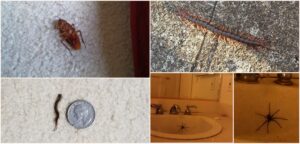
It’s hard to get pictures of critters so: Clockwise from the top left is a dead flying roach, a centipede out for a walk in our neighborhood, a cane spider that came to visit me in the bathroom one night, and the tiny centipede that bit my son while he was sleeping.
Also, just so you’re not surprised, we have other critters that are scary-looking but not too dangerous: we have these large brown spiders – cane spiders – that look really scary but don’t bite and aren’t poisonous and we have large, flying roaches. The roaches aren’t dangerous but they’re crazy and may try to fly toward your head if you swat at them. As a long-time resident of Hawaii, I have made an arrangement with those flying roaches…I’ll give them a wide breadth if they’ll leave me alone and not dive-bomb for my head. LOL.
One last random thing. I didn’t know they existed but now I want to see one! Oahu has kangaroos! If you want to see one, good luck ~ there isn’t a lot, only about 40 descended from a pair kept in captivity about 100 years ago. I just found this out in 2019 when I came across this article. Who knew?
2. Respect signs and markers.
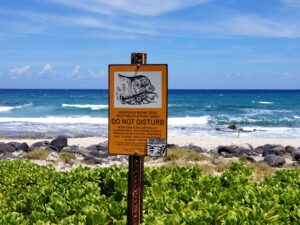
You’ll see these types of signs once in a while at beaches and on trails for different indigenous plants and animals.
This applies to safety signs posted at beaches and on hiking trails but also includes signs marking private property or sacred spaces. Some blogs and websites will mention “special hikes” or “going off the beaten path” but many of these “special” areas require you to cut through private property lines or trespass on sacred spaces. Please do not follow those recommendations. All beaches are required to have public access (except for certain US Military run areas) so there’s no need to cut through someone’s backyard and if a supposed hiking trail needs you to cut through someone’s private property without their permission, you are committing a crime. If you wouldn’t want hundreds or thousands of strangers invading your living room or backyard, please respect their property lines and don’t invade theirs. Also, if a sign says “KAPU” that means “KEEP OUT.”
3. Treat each other with respect.
Most people who’ve grown up in Hawaii are used to being outnumbered by visitors and it’s fine. I personally, enjoy finding out where people are from and, even though I’m more introverted, I often find myself being asked for directions or find myself chatting with strangers at a crosswalk, supermarket check-out line, or just about anywhere (that includes both tourists and locals! LOL). My husband is naturally super friendly so he just talks to whoever anyway!
I’m not going to rehash the tourists and locals discussion but I think this article covers a lot of points nicely. Instead, I’d simply like to point out that most people living in Hawaii aren’t here to beach bum and live out their best vacation life every day. Ha ~ we wish! Of course, for Native Hawaiians, Hawaii is their (rightful) home and then there are others who have immigrated from other states or countries and have stayed ever since. Some of my own great-great-grandparents immigrated at the turn of the century and we’ve just mostly lived in Hawaii for the past 100 years. So statistically, we’re just like the average Americans from the mainland ~ with approximately 80% never moving more than 100 miles from their hometowns. Instead, many of us like to make our home base in Hawaii and visit the mainland so, realistically, while you’re vacationing in Hawaii enjoying our beaches, sunsets, and weather, we may be vacationing in your cities, admiring your city’s skylines, mountain ranges, or…state fairs??! (Okay, to be fair, I just saw a ton of my friends’ Facebook posts about the Minnesota State Fair and I just miss them!). Anyway, with all of us visiting each other’s cities and countries, doesn’t it just make sense to treat each other well?! After all, karma and all that.

